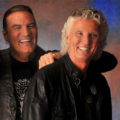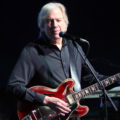Woodstock blues rockers Ten Years After earn deluxe expansion, book by beat keeper Ric Lee
 Photos provided by Chipster PR
Photos provided by Chipster PR
Since the Summer of Love, Ten Years After have rarely been strangers to the road, though just because these British blues rockers were sidelined by the pandemic, doesn’t mean they’ve stayed silent.
Co-founder Ric Lee temporarily swapped his drummer’s stool for an office chair, cranking out a whopping 448 pages for the autobiography, “From Headstocks To Woodstock,” which covers the fabled festival, more than 50 years of recording, plus personal encounters with the Grateful Dead, Led Zeppelin, Rod Stewart and mounds more.
As far as the group goes, its latest long player, “A Sting In The Tale,” just got expanded, deluxe edition treatment for American audiences who might have previously missed out, including a recent recording of the landmark “I’d Love To Change The World.”
Lee ran down both projects for Chicago Concert Reviews, along with the illustrious club scene of the 1960s, being part of easily the most iconic music event ever and what Ten Years After looks like nowadays.
 How cumbersome was it to compile nearly 450 pages’ worth of material or did it seem to write itself once you got started?
How cumbersome was it to compile nearly 450 pages’ worth of material or did it seem to write itself once you got started?
Ric Lee: Actually, not cumbersome at all. I was very lucky in that I had my own diaries and I had a copy of “Alvin Lee & Ten Years After – Visual History,” written by a very loyal fan, Herb Staehr, from Boston, Massachusetts. Herb gave a pretty accurate, chronological view of our career and this was the skeleton on which I was able to hang the flesh of my own stories and memories.
Take us back to the U.K. blues rock scene when Ten Years After started.
Lee: When we got started on the U.K. blues rock scene, there was a lot was happening. As I recall, Alexis Korner, who I like to think of as the “grandfather of British blues,” and his partner in crime, Cyril Davis, were resident at The Marquee Club in Wardour Street. A new young band, The Rolling Stones, were their support act. The Stones became more popular than Alexis and Cyril, and consequently, Alexis fired them. He did, however, take a keen interest in them and nurtured their subsequent progress.
Not far from The Marquee at The Flamingo Club, in another part of Wardour Street, acts such as John Mayall & The Bluesbreakers, Georgie Fame and The Blue Flames, Zoot Money’s Big Roll Band and many others were becoming very popular. Lucky enough to pass an audition at The Marquee, we were given our first gig – the interval slot as The Bluesyard, the only gig at which we used that name – on a Sunday evening supporting The Bonzo Dog Doo-Dah Band. Further support spots followed until, as our reputation grew, we became headline attractions. Due to all the blues activity at this time, one of the music papers dubbed it as “The Blues Explosion.”
What led you to catching wind in America?
Lee: Because of our success at The Marquee, the organization asked us to perform at The Windsor Jazz & Blues Festival they promoted in the summer. Many artists that played The Marquee were also on the bill: [ex-The Yardbirds guitarist] Jeff Beck and [The Animals singer] Eric Burdon, to name but two. We received a standing ovation, and after the show, Mike Vernon, then a staff producer at Decca Records, who at the time was producing John Mayall & The Bluesbreakers, signed us to Decca’s offshoot Deram label. Our first release, “Ten Years After,” “escaped” in America.
 Luckily, Bill Graham, promoter at Fillmore West in San Francisco, heard it and telegrammed our manager, Chris Wight, to suggest that if we were ever in the U.S., he’d like us to play at his venue. Chris immediately sought finance; songwriting advances, tour support, etc. to get us our first tour in 1967. We played Fillmore West to great acclaim and Bill invited us to stop off in New York City on our way home to England to play a new venue he was opening there, Fillmore East, which we duly did. Legendary agent, Frank Barsalona, booked us thereafter and was instrumental in helping us on our way, through clever packaging with better well known U.S. bands.
Luckily, Bill Graham, promoter at Fillmore West in San Francisco, heard it and telegrammed our manager, Chris Wight, to suggest that if we were ever in the U.S., he’d like us to play at his venue. Chris immediately sought finance; songwriting advances, tour support, etc. to get us our first tour in 1967. We played Fillmore West to great acclaim and Bill invited us to stop off in New York City on our way home to England to play a new venue he was opening there, Fillmore East, which we duly did. Legendary agent, Frank Barsalona, booked us thereafter and was instrumental in helping us on our way, through clever packaging with better well known U.S. bands.
Can you recall any shows with the group around town?
Lee: I remember playing at the Kinetic Playground, formerly the Electric Theater, promoted by Aaron Russo, original manager of Bette Midler and later to become the producer of the movie “Changing Places.” We supported The Moody Blues at that gig. I know we played several other venues in Chicago over the years, whose names I don’t remember now. I do remember, however, that we supported B.B. King one time, John Mayall on another and worked alongside other artists on different occasions.
Regarding Woodstock, was it really as mythical as it’s become over the years?
Lee: I think the myth has built over time, but it was a terrific gig to play. It did what it said on the tin, [which was a] festival of “Peace, Love & Music.” The film the following year certainly put Ten Years After on the world stage.
What do you remember most about the performance?
Lee: Probably the nervousness of having to start “Good Morning Little Schoolgirl,” in front of a quarter to a half-a-million people, three or four times because the guitars refused to stay in tune. This was due to the damp evening atmosphere following the afternoon storm. I also remember the fantastic patience of the crowd and their tumultuous reception at the end of our set, and of course, [late singer/guitarist] Alvin [Lee] carrying off the huge watermelon someone rolled on to the stage. I’ve no idea to this day what happened to that piece of fruit!
 Was there anything you’d like to relive from that day or wish went differently?
Was there anything you’d like to relive from that day or wish went differently?
Lee: No, not really. I have great memories of that day and will carry them with me as long as I’m around, I hope.
Beyond that fateful day, who are some other musician encounters you write about?
Lee: My relationship with Jeff Beck when we were neighbours in deepest Kent, England. My friendship with the Black Sabbath guys in the early days, from them being our support band in Birmingham, to my business involvement with [guitarist] Tony Iommi later. Jamming with Jeff Beck, [Led Zeppelin guitarist] Jimmy Page, [Jeff Beck Group/Faces singer] Rod Stewart, [Led Zeppelin singer] Robert Plant, [Led Zeppelin drummer] John Bonham, [Cactus drummer] Carmine Appice, [Cactus bassist] Tim Bogert, [Jeff Beck Group/Faces guitarist] Ronnie Wood and [Jethro Tull bassist] Glenn Cornick at the Singer Bowl in New York City, boozing with Robert Plant, John Bonham, [Colosseum singer] Chris Farlowe and [The Foundations singer] Clem Curtis, and meeting the guys in Canned Heat, Jefferson Airplane and the Grateful Dead on our first U.S. tour.
What do you ultimately hope fans will take away from the book?
Lee: That it’s a “good read,” and if they think it is, to tell their friends, who may or may not know me, or Ten Years After.
There’s already mention of a second volume. How far are you and what will that comprise?
Lee: I’ve got two rough chapters outlined so far. The plan is to complete my history up to the present day-ish. Not sure if I’ll make it, but I’ll give it my best shot. That’s if I get time to write it during promotion of “From Headstocks To Woodstock!”
What’s coming from the U.S. edition of the band’s latest album?
Lee: Deko Entertainment is releasing the current line-up’s “A Sting In The Tale – Deluxe Edition,” [which features guitarist/vocalist Marcus Bonfanti, keyboardist Chick Churchill, bassist Colin Hodgkinson and Ric on drums], as a special bundle. It’s called the “Deluxe Edition” because it has four bonus live tracks, including “I’d Love To Change The World,” which was a big U.S. hit in the ‘70s for the original line-up of Chick Churchill, Alvin Lee, [bassist] Leo Lyons and me.
 Why did you decide to keep the band going, in spite of losing Alvin?
Why did you decide to keep the band going, in spite of losing Alvin?
Lee: On a tour of Europe with my old friend Kim Simmonds, guitarist/singer of Savoy Brown, the promoter asked me if there was any chance of getting Ten Years After back together, to which I answered in the negative. Prior to that, I’d worked with EMI Records, owners of our back catalogue at the time, to revamp the catalogue to give it a new lease of life and the fans some value for money. I called Alvin to ask if he’d like to get together again to promote the new releases, but he turned down the idea. Almost as soon as I’d got home from travelling with Kim, I had a phone call from the promoter of Kim’s tour. He’d been let down by the backing group of an American blues artist with whom he had 15 dates to fulfil. Would I contact Leo and Chick and see if they’d step in with me to help him fulfil the dates? We did. On that tour, it became very obvious that audiences were still keen to see Ten Years After.
To cut a long story short, Leo, Chick and I engaged a young, very talented guitarist/singer, Joe Gooch. Together, we toured very successfully in Europe and America for approximately ten years. Joe then decided that was long enough for him and he wanted to “do his own thing.” Leo decided he’d go along with Joe. Chick and I wished them well for the future and decided it would be good to continue as Ten Years After. Not ready to retire, we determined to build on the song heritage that Alvin had left us and create new material to move forward. Colin Hodgkinson, an old friend and amazing bass player, was happy to join us. After much searching, I managed to find Marcus Bonfanti. Since then, we’ve never looked back and the band has gone from strength to strength.
For additional information on Ten Years After, visit Ten-Years-After.co.uk.








